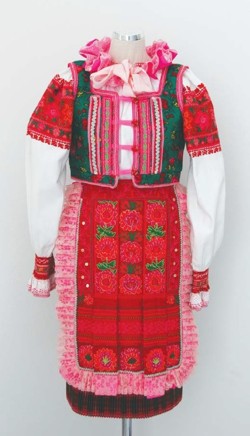Diana Némethová
Even though it might appear that folk costume is synonymous with a multi-coloured folk dress with an abundance of colours, this was not always the case. The most important role in folk clothing was held by white, starting in the times when people stopped wearing raw animal furs and pounded the first wool cloth or wove the first cloth. Home-made natural materials (flax, hemp, wool) have a natural, discreet colour after processing, that is various shades of white. With time, sun and water, the greyness or brownness of the natural colours of plant fibres gradually disappeared, and the cloth took on a snow-white colour. With the discovery of this natural phenomenon, whitened cloth for clothing became the higher standard. Later, other colours found their place in clothing: from the 18th century, the craft dying of home-made cloth blue became widespread. The phenomenon of colour only developed fully in the 19th century, when industrially dyed fabrics and thread became accessible for the wider mass of people.
